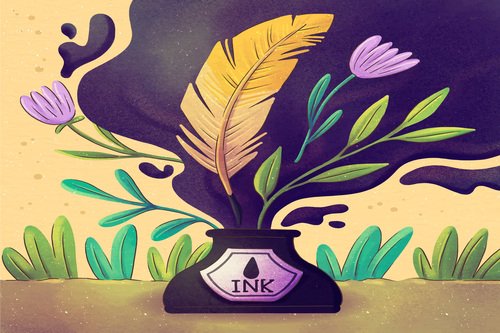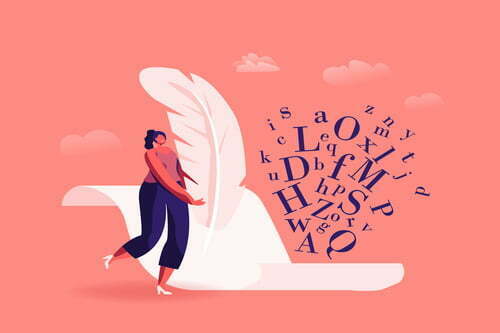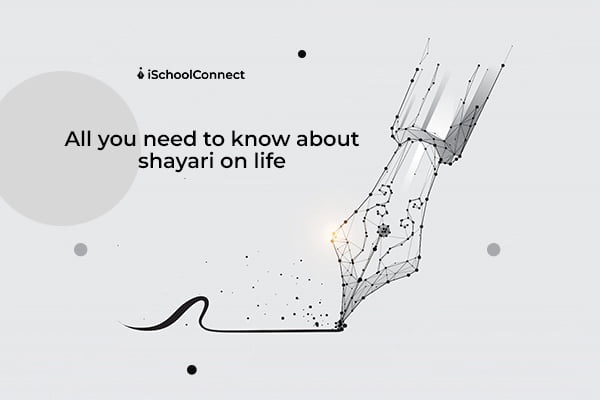Table of Contents
“Shayari” is an expression of heart and soul poured into words, a feeling forged from good and bad experiences in one’s life. Shayaris have a very vast range of expressions raised in one’s mind. The origin of Shayari is not known, but it is related to variations in culture and understanding of art and its expression in a form that speaks out the contents of the heart. It is more than a freestyle, a deep study of literature to understand the ideology behind such strong words portraying ground-defying emotions in a simplified form. This expression led to various forms of Shayaris like love, hate, pain, romance, loss, breakup, life, and many more. Keep scrolling to know more about Shayari on life!
History of Shayari on life
Shayaris became popular in the 1200s; Amir Khusro (1253–1325) is regarded as one of the world’s greatest Shayars; he composed in Persian and Hindustani. Mirza Ghalib is regarded as the supreme authority in the field of Urdu poetry. He was born in Delhi and died there in 1869. It was started in the Persian language, but due to the Persian blend with Sanskrit formed a new language which we now know as Urdu; it has been expanded to other languages too. People used to send letters called Shayari, in which they communicated their opinions and ideas. The writer’s serious thoughts, feelings, and experiences were reflected in these two sentences. Respondents could also send their responses in Shayari.
Shayars write Shayari, which is a type of poetry. This type of poetry is traditionally read to an audience in a particular setting known as a mehfil. Even though many professional shayars make Shayari for a living, it is a very popular type of poetry among amateurs. Amateur Shayari is still mostly inspired by romance and beauty. Professional shayars, on the other hand, are more likely to write about societal themes that appeal to a wider audience.
Scriptures on Shayari on life

Shayari, or poetry, in Urdu, Punjabi, and Hindi is mainly made up of couplets, or Sher. Ashaar is the plural form of Sher. Ghazal is a compilation of several ashaar, each of which should express a complete notion without referring to other Shayari in the same ghazal. Even though they are part of the same ghazal, the distinct ashaar within it might have very different meanings and tones.
In the current context, four-line Shayaris are very often used, especially in Hindi. Shayaris on life often explains the life a person lives with regrets as well as opportunities. If we are on the joyful side, it brightens our life, and when on the sad side of life, it lets our emotions flow through the tip of a pen. It rescues us from depression and sets us on a new path to embark on, a journey filled with hope and cheer.
Human connection
The Language of Urdu and Shayari is strong because of their phonetics and vocabulary compared to any other language. Poetry is as old as human culture, but no other form of poetry made such a deep connection to the ideas of an individual in a few words, value to the depth of expression with no harm, whether physical or mental. How these Shayari are expressed in verses so contextually in few words makes them eye-catcher, few of them as mentioned below.
Significance of Shayari on life

The choice of words is crucial in expressing feelings about someone who has attitudes. Shayari is used in different styles and variations such as Sher, Bait (Another term for SHER, Sher-o-Shayari, Shayari), Bait-Ul-Ghazal, Ghazal, Fard, Hamd, Hazal, Hijv, Husn-E-Matla, Madah, Manqabat, Maqta, Marsiya, Masnavi, Misra, Munajat and few more. During the period of the dynasties, emperors, kings, Nawabs, Sultans, and Badshah appointed shayar as Durbar (circle of Important People). They were paid salaries and given awards to entertain the monarchs. Mushairas, a public function used to be organized which is attended by shayars (poets) whether professional, beginners or first time to host healthy competitions between Shayars. Audiences take some fruitful lessons from those Shayaris.
Love Shayari has powerful words and inspiration to express the feelings of lovers’ hearts to their counterparts.
“Tere ishk me is Tarah jee raha hoon, Subah se sham tak lagakar pee raha hoon”
Sad Shayari expresses the heartbroken feelings of a person by his most loved one.
“Na Gila karenge na sikha karenge,
Tu Salamat rahe bas yahi dua karenge”
“tum jo naa aa’e the to har chiiz vahii thii
kih jo hai aasmaaN hadd-e-nazar, raahguzar raahguzar, Shiishaah-e-mai, shiishaah-e-mai”
Romantic Shayari- This type of Shayari is a medium of communication between two persons to communicate their expressions.
“nahiin ki mujhako qayaamat kaa etiqaad nahiin shab-e-firaaq se roz-e-jazaa ziyaad nahiin”
Birthday Shayari- is used to send wishes like Shayari.
” Tum jio hajaro saal Sal me din ho ek hajar”
Funny Shayari– We used it for comedy and to make people laugh and relax from stress.
“Kuch dost aise bhi hote hai jindagi me.
Sau rupye udhar mangte ha, hajar ka note jeb me rakhkar”
How to write a Shayari?
In terms of writing a decent Shayari, certain factors must be considered, such as the theme, style, depth of thinking, and inventiveness. Let’s first learn about the components of a Shayari before moving on to how to write an emotional Shayari.
If you’re a beginner who doesn’t know anything about Shayari, the first and most important thing you can do is read a lot. Now you’re probably wondering why I’m telling you to learn. The simple explanation for this is that if you read or research other emotional Shayari on the internet, you will gain a fundamental understanding of how to compose or structure an emotional Shayari.
Because every pain is unique, composing a Shayari in a unique way that expresses one’s feelings is important. Shayari’s motivation could be the same. It will be the best, and it will be one of a kind if original feelings are poured into it. Readers want Shayari which is one-of-a-kind. Expressing oneself and uniqueness is the key element. You can copy someone’s writing style or structure for a Shayari, but avoid using identical terms.
Present days Shayari

The current generation is known as the “electronic age.” Various communication mediums are now available. As a result, these mediums are not unexplored and are regularly employed in shero Shayaris. Today’s Shayaris are heavily influenced by social media. People are openly using these channels to express themselves in the words of Shayari. These social platforms and media have supplanted the letter-writing practice, which took a long time to reach its intended recipient.
Firaq Gorakhpuri, Majruh Sultanpuri, Josh Malihabadi, Mirza Galib, Meer Taki meer, and Allama Iqbal, Kaiffi Azmi, Bashir Badra, and Vashim Barelvi were notable Shayari in Shayari history. They were well-known for their Urdu Shayari. Gulzar, Rahat Indauri, Kaka Hathrasi, Kumar Vishwas, and others are prominent Shayari in Hindi.
The portrayal of thoughts, sentiments, and motivations in a Shayari on life is the presentation of expressions. If represented correctly, they have power and values. If we pass them at the appropriate time and in the right way, they can transform someone’s life.
In life, Shayari is a vehicle for exploring ideas. These are widely used to express the speakers’ thoughts on TV debates, meetings, public meetings, and many other locations. The speaker’s idea is also understood by the audience as Shayari’s words.
Key takeaways
- Shayari on life has the concept of a way of living a life.
- Shayari on life gives light to happy and sad parts of life.
- Shayari on life shows entertainment in life and keeps people happy, smiling, and cheerful.
- Shayari on life brings us from a difficult situation in our lives and glare on the face.
We hope you enjoyed reading this blog. In case of any queries, reach out to us or drop a comment below!
Liked this blog? Read next: Encouraging Bible verses: How to apply them to your life
FAQs
Q1. Who were ancient shayars?
Answer– Mirza Galib, Allama Iqbal, Faiz Ahmad Faizi, Firaq Gorakhpuri, and Mir Taki Mirm are among a few ancient shayars.
Q2. Who are the famous Urdu shayars?
Answer- Some famous Urdu shayars are Munauvar Rana, Rahat Indauri, Bashir Badra, Vasim Barelvi, Kafi Azami, Nida Fazli, and Gulzar.
Q3. Is writing shayari difficult?
Answer- No, it’s not all that difficult if you have a knack for such things. However, writing shayari takes a lot of effort, determination, and concentration.
Q4. Is understanding shayari difficult?
Answer- If you are aware of languages and literature like Hindi and Urdu, you can grasp them







